


www.farmboyzimsflightsims.com
FBZFS
Click On Any Picture For A Larger View

Thanks For The Visit !


I bet I'd be a multi-millionaire if I had a nickel every time the word "realism" came up at development meetings, or in emails between developers (would that be taxable? Hmmmm..)! If you haven't noticed, realism is THE goal of the creators of addons and the simmer, virtually duplicating, as close as possible, the real world flight environment. Newcomers to the virtual skies might hear the stories of the “square gauges", and scenery that resembled a geometry test, but not having "grown up" with the sim industry, some may take what is offered these days for granted. Everyone eagerly anticipates what the future of simming has in store for us! The future is only seconds away! An example of this realism comes from Phoenix Simulation Software (PSS), and the folks at Just Flight with their release of the Boeing 777 Professional.
When I wrote the review of the Concorde, also from Just flight and PSS, I had said that my interpretation of the word "Professional" when used in conjunction with these products, not only meant a professionally developed product, but also that you, the simmer, needed to be a "quasi-professional" with some hours under your belt in the virtual skies. The same holds true for this product, the 777. The 777 is, however, a bit easier to manage than the Concorde. Let me give you a brief history of the 777, a truly remarkable, and in some ways, unique aircraft.
The development of the Boeing 777 Wide body Twin has more advanced technologies built into it than any previous aircraft from Boeing. The 777 is yet another example of the "how can we make it better" thinking that has been alive and well in the aviation industry from the start. The 777 first showed up on the drawing boards as a stretched 767, but that page was torn from the design book, and an entirely new design was conceived. The new concepts included a uniquely designed fuselage cross-section, the first application of "fly-by-wire" technology, a glass flight deck outfitted with no fewer than 5 LCD's, 10% by weight use of composite material in the construction, and advanced and quite powerful engines. To fit into tight spaces at restricted airport facilities, the 777 was offered with the option of having the outer 21 feet (6m) fold upwards.

When the 777-200, was launched in October 1990, two versions were offered; the basic 777-200 and the Increased Gross Weight, longer range version, the 777-200IGW, later redesignated the 777-200ER. United Airlines took the first batch in May, 1995. The first 777-200IGW/ER was delivered in February of 1997 to British Airways.
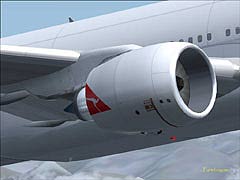
The 777-200LR is capable of flying 8,865nm (16,417km) with 18 hours of flying time, making it one of the longest ranging airliners cruising the skies. No wonder these aircraft are equipped with overhead crew rest compartments! The driving force behind this feat is the extremely powerful GE90-110B1 turbofan engines, with a thrust rating of 110,000 pounds (489kN). An increased max takeoff weight, optional auxiliary fuel tanks located in the rear cargo hold, 6.5 ft (2m) raked wingtips, new main landing gear, and structural strengthening are all part of the Long range package.
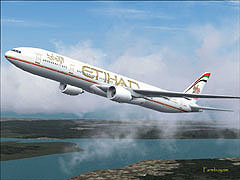
The Boeing 777-300 is a stretched version that was designed as a replacement for the earlier 747-100's and
200's. The 777-300 is powered by the world's most powerful turbofan engines that pump out 115,300 pounds (512kN) of thrust. The 300 has about the same passenger capacity and range when compared to the 747, but burns up one third less fuel and costs 40% less in maintenance costs to operate than the 747. A significant improvement. When compared to the 777-200, the stretched 300 is 33ft 3in (10.13m) longer, with "plugs" being added fore and aft of the wings, allowing up to 550 passengers in the single class configuration. To handle the increased stretch and the Max T/O weight, the 300 has a strengthened undercarriage, airframe and
inboard wing. A tailskid and ground maneuvering cameras mounted on the horizontal tail and underneath the forward fuselage are also included in the 300 model.
At the Paris Air Show, in June of 1995, Boeing announced the development of the 777-300, and also clued everyone in on who was going to get the first one's hot off the assembly line. 31 orders were placed for the 777-300 from All Nippon, Cathay Pacific, Korean Airlines and Thai Airways. Like the 777-200, a 777-300ER long range version has been developed. Changes made to the 777-300ER are more powerful General Electric GE90-115B engines (currently the world's most powerful jet engine), raked wingtips, strengthened body, wings, empennage, nose gear, engine struts and nacelles, new main landing gear, and provision for extra fuel tanks. The range, carrying 365 passengers, is increased up to 13,427km (7,250nm).
An extremely fun and rewarding aircraft model awaits you with the Just Flight/PSS model of the Boeing 777 variants. Here are some of the features:
Detailed features:
* 26 high quality world wide airline liveries
* -200LR, -200LRF Freighter and 300ER variants.
* Authentic flight modelling.
* High quality visual model.
* Superb 2D instrument panel and gauges.
* Operating and realistic WXR2100 weather radar!
* Fully interactive Virtual cockpit.
* Animated undercarriage, including "gear droop" flaps, elevators, rudder, spoilers, ailerons, flexing wings, APU Inlet RAM air turbine, cargo and cabin doors.
* Detailed engines with rotating 3D fans and operating thrust reversers.
* Special lighting effects.
* Reflective Glass Windows.
* Reflection Mapping.
* Dynamic specula highlighting.
* Individually Switched Lighting:
Navigation lights
Beacons, Landing and Taxi Lights.
Panel Floodlighting & Cabin Interior Lighting
Instrument gauge lights, tail logo lights.
* Fully detailed Virtual Cockpit Includes:
High Resolution vector drawn gauges
Animated Control yokes
Animated Rudder Pedals
Animated Throttle Levers
Reflective Glass On Gauge Faces
* PSS "REAL" Features:
Lighting effects
Wingtip Vapor trails
* Extensive printed manual.
* Flight tutorial.
* Load editor and panel configuration utilities.
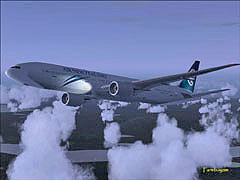
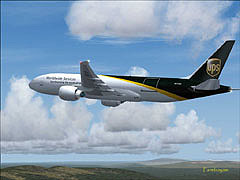
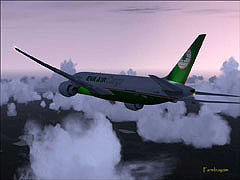
As usual, we'll start with the outside and work our way in. It's getting harder these days to tell a picture of a real aircraft from that of a flight sim screenshot! The smallest of details has been attended to in this product, with smooth fuselage and wing modeling, and the control surfaces are, of course, fully functional and detailed, as well as functioning doors, hatches and reverse thrusters. Exterior lighting shows up beautifully at night. Contrails and wingtip vapors, along with tire smoke when landing are also present. The closer you look the more detail you're going to find! I must admit that I don't "hang around" outside of the aircraft too much, but the addition of the interior cargo and operating cargo doors and hatches really does add to the realism of the model. The pics speak for themselves!
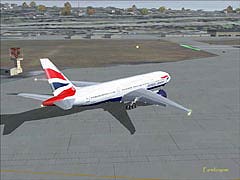
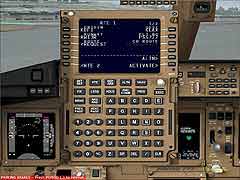
As far as the flight deck goes let me just say this... WOW! The exterior isn't the only place where you're going to find loads of detail! Panels are crispy clear in both 2D and VC viewing modes. "Hot Spots" to click on in various locations of the panel allow for easy accessibility to sub-panels. If you have experience with flying the default heavies in MSFS 2004, you should catch on quick with this aircraft. The panels are not overly complicated, with loads of functioning controls. One particular item that I liked very much was the ability, in both 2D and VC, to bring up an enlarged version of the glass panels for easier viewing for us folks with bifocals! In the middle image to the right is an example of this with the Navigation gauge (ND) enlarged. All three panels can be
The topic of 2D cockpit panels vs. Virtual Cockpits has been popping up here and there in the forums and various magazines, so here's my 2 cents on the subject. Keep them both! I enjoy using both equally. It all depends on the situation and the aircraft. With these newer, more advanced products that are out there these days, it's almost routine to feature excellent renderings of panels in VC mode that are fully functional. This is especially great if you have TrackIR from edimensional (which is oh so conveniently available from my site! Hint Hint!). From the VC perspective, with adjustments to your "seat" (eye view), not only are you seeing eye candy, you're seeing eye candy that works! I found loads of differences as far as quality goes, between the default and the PSS 777. One notable difference was the lighting and image quality in the various views in both modes. If you like the default 777, you're going to love this one!
Another major difference between the two is the implementation of a Flight Mission Computer/Computer Display Unit (FMC/CDU). The FMC is the "Brains" of the outfit, while the CDU is the interface with the FMC. Most high-end aircraft addons these days have FMC's, so if you've ever used one, this will be a piece of cake for you. If you haven't flown using an FMC/CDU, you're in for a different kind of flying experience! You access the FMC through the Computer Display Unit (CDU). It's here that you'll enter all information about your aircraft's characteristics, location data, flight data, and when you want your cup of coffee served! Actually, I think they're still working on the last! The FMC/CDU is the tool to get the job done. It fly's the aircraft for you, from waypoint to waypoint, and will set up your landing also. An ingenious piece of avionics’ technology! It literally does the "thinking" for you. As an example, it will set up the most effective way to take off, climb, cruise, and descend, based on all incoming data
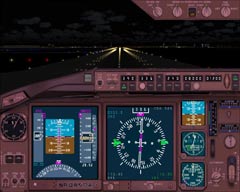
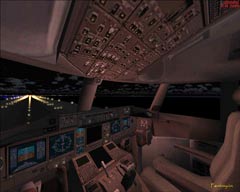
2D View and Virtual cockpit views of default 777 (Not "retouched". VC lighting is poor in the MSFS 2004 Default 777.
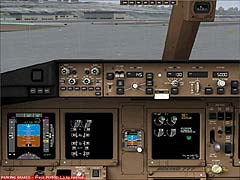

2D View and Virtual cockpit views of PSS 777
regarding changes in environment and aircraft weights and fuel. It can seem a bit intimidating at first, but the way I figure it, if you're able to turn your own personal computer on, and do whatever it is you do (I'm going out on a limb here and assuming that you use the PC for things other than just simming!), you'll be able to follow along with the tutorial, which covers all the bases, taking you on a flight from KBFI to KLAX, a short hop for a 777! The tutorial is well written and not hard to follow. It takes you from a cold and dark start, to the landing at KLAX. Along the way they'll put you through the paces of working with the FMC/CDU. The first time through the tutorial, it took me approximately 35 minutes or so to get her rolling. Even though I've used FMC/CDU's before, I wanted to see how long it would take to work through the tutorial. I figure anywhere from 30 to 60 minutes for the folks new to the use of the FMC/CDU, and want the ultimate in realism. The tutorial is covered in the printed manual that comes with the disc, and includes performance charts, checklists and everything else you ever wanted to know about the 777! Read it through if you're new; keep it handy if you're seasoned! The manual is well written, 128 pages, and an invaluable reference item. The only negative thing I can find to say about the manual is that the binding is coming loose from flipping back and forth quite a bit. I'm one of those bookworms, so I noticed this.
Something that I think adds loads to the realism is the aural warnings from the Ground Proximity Warning System. Here's what you'll hear;
"Sink Rate”, "Pull Up", "Terrain, Terrain", "Don't Sink", "Too Low, Terrain", "Too Low, Gear", "Too Low, Flaps", and "Glideslope". When you hear these warnings, take heed! The GPWS isn't talking just to carry on a conversation! You'll also hear call outs on the approach of your altitude from 1000 feet above the runway, to 10

Being only a PC pilot, flying a real 777 is still a ways off for me! Light years perhaps! But the flight dynamics of this model "feel" right for something of this size and power. You'll notice subtle and not so subtle differences in how it handles from other aircraft and from the default 777. These models have come a long way, with the implementation of the FMC/CDU, TCAS, verbal warnings, and other improvements, both in looks and in programming.
This is a product that I think all would enjoy, though for newcomers to the virtual skies, there will be a learning curve in order to fly this aircraft model like it was intended, realistically! It seems to me that would be the driving force behind buying this product, for the realism. But I think you'll have fun and with practice and a bit of patience, you'll be navigating and flying the 777 in its many variants, in no time at all!
The product took 2 minutes and 25 seconds to install onto my system. How's that for fast! During install, you will be given options for what variant and what liveries you want installed. I went with all of them! You can also choose to load the tutorial or not. You can always modify your selections from the disc. Now, the disc itself is something to talk about. I've always been a fan of the animated "movies" at the beginning of some of the flight sim products, and to my delight, the disc is loaded with videos of the Just flight products "on the shelf"! I thought they were not only fun to watch, but a great marketing tool. It shows confidence in their products to put them on display, and also gives the buyer a good look at what they might want to buy, which can also be done, using the disc and an internet connection. Some of the products are offered as demo versions; giving you an opportunity to take a particular product that you may take a fancy to around the mountain for a spin! Just Flight has got the bases covered! There's some treats for you on the disc also, like a free aircraft, a Spitfire no less, and other little goodies. I must admit that I am a fan of Just flight products for many reasons, but the one that stands out is their commitment to the simmer. I think they get the drift on how to keep us simmer's happy!
There are a lot of areas to cover when reviewing these types of add ons. I've given you a look at some of the things that sets products like the 777 Professional apart from default and other, less detailed models. For more information you can visit the Just Flight website at www.justflight.com.
For the price of $44.99 USD / £ 29.99 / € 44.95 this is a purchase not to be taken lightly! Most addons of this quality are comparably priced, so, in my humble opinion, if you are a Boeing fan, you may not want to miss out on this one. Virtual Airline pilots would also enjoy this model, for the ease of flying and the challenge of aviating! If you want realism, the 777 is quite the aircraft model, giving you a taste of what it must be like (almost!) to fly the "Heavies"!
Just Flight and Phoenix Simulation Software
Boeing 777 Professional
Reviewed by Farmboyzim





















To begin the tutorial, you need to start with the default Cessna at KSEA, and then select the flight from the menu, whereupon it loads and you'll find yourself in a British Airways livery at KSEA. Smooth sailing from here! Once you get through the tutorial, and perhaps run through it a couple of times, you'll find starting this beast is as easy as starting your car, almost!
A simulated weather radar, the Collins WXR2100, developed by Praxmarer Florian of Add-On Gauges is yet another part of this great avionics suite (image at left). The Collins WXR2100 is used by major airlines, (B737 to the B777 and all Airbuses). Precipitation, Turbulence, and Wind Shear can be detected. A manual in PDF format can be found under the Start menu, Just Flight heading. The unit is in itself fairly simple to use. It's how to read and interpret the data that takes a bit of know how. The manual is only 21 pages in length, is in PDF format, and easy to follow.
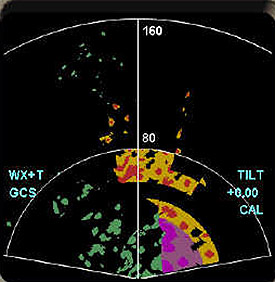
feet. A "Minimums" warning will let you know when you are below Decision Height, along with an "Approaching Minimums" call out 100 feet above DH. The addition of the aural warnings is not only cool, but an excellent aid while you are busy multi-tasking your brains out!
A Traffic Collision Avoidance System (TCAS) is also employed to keep you aware of the surrounding traffic in your area.
enlarged at once and sit conveniently at the bottom of your panel. The many "pages" of the MFD's are very impressive, detailed, and extremely realistic in appearance, and offer a wealth of information for the pilot., i.e., Electrical, Pneumatics, Flight Controls, Gear, Door, and a checklist page.
Screenshots










































